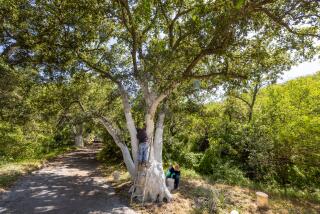Borers Kill Fruit Tree Branches
- Share via
QUESTION: Our three fruit trees — a peach, a plum and a nectarine (all big and mature)--were beautiful and full of fruit last year, but this year major branches have died back, and the bark on the upper surface of these branches is brittle and falling off. There is also some jelly-like material oozing out of the bark in spots on live branches. What happened, and can I save my trees?
ANSWER: It sounds like you have a classic case of peach tree borer--grubs that eat away the growing tissues under the bark of stone fruit trees, and, if unchecked, soon kill the trees.
Treatment includes picking away the sloughing bark to find active grubs and kill them; summer spraying of the entire tree--trunk, branches and all--with Sevin (carbaryl) or Malathion three times at three-week intervals starting about Mother’s Day, and an annual winter application of “dormant spray.”
While it may yet be possible to save your trees, I’m afraid that with the demise of some major branches they will probably be misshaped for years to come.
This late in the season you might still find some grubs under the bark, but it’s useless to spray until the trees lose their leaves. Then saturate them completely with dormant spray, and plan on spraying after next Mother’s Day.
For those with healthier stone fruit trees, the recommended winter and spring sprays will prevent these nasty and devastating creatures from taking hold.
Where to Find Pecan Trees in the Southland
Q: I’m desperate for pecan trees and have looked for them for many years without success. Where in Southern California can I go to buy them?
A: I checked with California’s two main suppliers of pecan trees and found a few retail nurseries in the Los Angeles and Inland Valley areas (but none in Orange County) that handle pecans. The main varieties they carry are ‘Western Schley’ and ‘Mohawk,’ which are both excellent in this area. You might check with one or more of them to see if they still have any in stock or to verify that they will have them this winter:
Los Angeles Area Gardena: Moneta Nursery Newhall: Green Thumb International (several other cities, too) Sylmar: Cooper’s Hardware Topanga: Sassafras Nursery Walnut: Sunshine Growers (several other cities as well) Woodland Hills: Boething Treeland
Inland Valley Area Ontario: Sunshine Growers (several other cities too.) Riverside: Cherry Valley Nursery. Upland: Mt Fuji Nursery. Yucaipa: Newell Nursery.
Perhaps there are others, but these are the ones the suppliers identified for me.
What’s Causing Aloe’s Nauseating Odor?
Q: Last fall we moved into a new residence that had a very large Aloe plant in the rear yard. We repotted it and now find that it has developed a very nauseating odor when cut. No one seems to know what went wrong, or if there’s a cure. I would greatly appreciate an answer before purchasing a new plant or destroying the old one.
A: Aloes are succulent plants that easily tolerate drought, but they cannot endure damp or poorly drained soil. Your plant’s symptoms sound like the result of root damage due to excessive moisture. Be sure the container has drainage holes and that the soil mix is porous. Let the soil dry thoroughly before re-watering. Unfortunately, if the newer leaves are showing these symptoms, the damage may have gone too far already, and the plant may not recover. If you obtain a new one, just remember that Aloes practically thrive on neglect!






